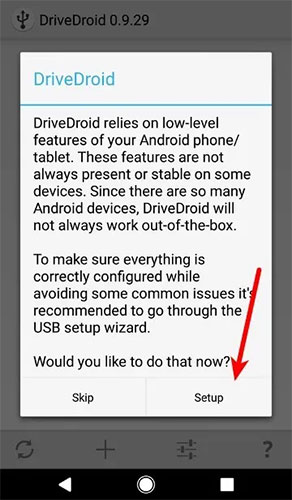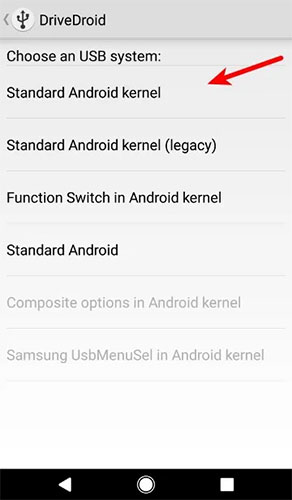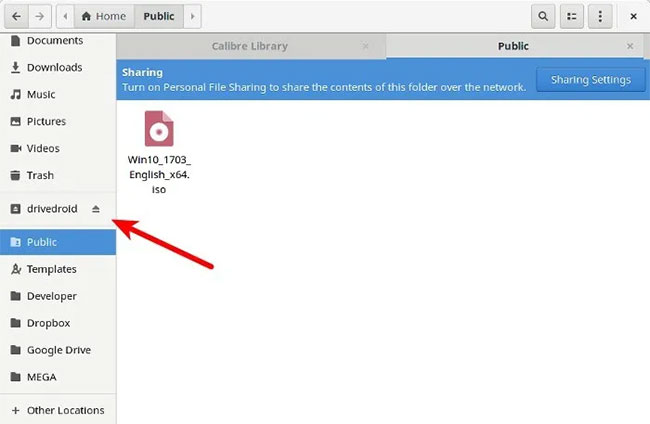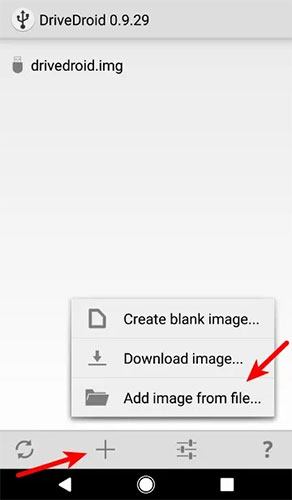How to install Windows 10 using Android phone
What is DriveDroid?
DriveDroid is an Android application that allows you to mount an operating system disk image and make it act as an installation media, such as a bootable USB flash drive or CD/DVD-ROM.
You can use DriveDroid to install many types of operating systems. It is often associated with Linux distributions, but you can also use it to install Windows 10.
Important note : DriveDroid requires Android root access.
Rooting is a process that gives you privileged access to the device. It allows an application to control and access more than a standard application. Rooting is similar to jailbreaking an iOS device.
You may ask whether root is still useful for Android devices. However, as you'll see from this guide, there are definitely some uses for this!
If you want to root your Android smartphone, check out TipsMake's guide: Summary of some ways to root Android devices. From experience, Magisk is the easiest method to root your device - but you'll need to back up your system before doing so as the process can erase everything on your device.
Request
- Android device is rooted.
- 4.5 GB of free space on Android device.
- Windows 10 ISO installation file.
How to install Windows 10 from Android device with DriveDroid
If you do not have root access on your Android device, the rest of this guide will not work properly. DriveDroid requires root access on the device to properly mount Windows 10 ISO. You will also need root access if you want to install another operating system, such as a Linux distribution. From now on, this guide assumes your Android device has root access.
To install Windows 10 from an Android device, you will need a copy of Windows 10. The Windows Media Creation tool is the easiest way to download the latest version of Windows 10. Once you've downloaded the Windows 10 ISO file, you need to copy it to your Android smartphone in an easy-to-remember folder. It's best to copy the files to your Android using a USB cable, as you'll also need a connection for the rest of the tutorial.
Establish
First, you need to install DriveDroid on your device. The current free version works best with Android 9 devices. However, it's still one of the best options, even if it hasn't been updated in a while.
Once the installation is complete, you can run the USB installation wizard to configure the application. Click Setup to start.

It will verify that your device is not blacklisted. Click Proceed , then grant root access to the app.

Next, connect your Android device to your PC using a USB cable.
You need to choose from the list of systems for USB processing. Most devices will work with the first available USB system.

Finally, open the file manager on your PC and confirm whether your device is mounted as a USB drive or a CD drive. This shows that your device works well with DriveDroid. You can close the Wizard and continue with the rest of the tutorial.

If your device doesn't show up at all, go back to the previous page and try other USB systems until you get one that works.
Create Windows boot image
Once you have scaled up the initial setup, creating a bootable Windows ISO on an Android device will be easier.
Follow the steps listed below and make sure your device is still connected to your PC before continuing.
1. Download the latest Windows 10 ISO file and move it to your device's internal memory or SD card.
2. Launch DriveDroid and press the '+' button at the bottom of the screen.
3. Select Add image from file .

4. Name the image and click the magnifying glass icon to select the path of the ISO file. Once done, tap the check mark at the top to save.

5. Click on the newly created entry and select one of the storage options. CD-ROM is suitable in this case.

6. Your Windows image will be mounted now. A notification will appear on your phone indicating that the image has been successfully mounted.

7. Finally, restart your PC and boot from the drive where your Windows ISO is installed.
You may need to enter the boot menu if your PC has not been set up to boot from external devices or drives first. During the boot process, press F8, F11 or Del (button varies depending on your PC) to access the boot menu. Select the UEFI option with the name usually starting with Linux File-CD.
Windows will boot normally and you will be able to continue the installation process from there.
The Drivedroid application allows connecting and installing Windows 10 from a rooted Android device easily without the need for a USB or CD ROM. Try it out and share your thoughts about this app!
You should read it
- Steps to run Android apps on Windows 11
- How to turn off and restart Windows PC from an Android phone
- You can now run Android apps on Windows 11
- How to experience Android on PC
- How to run Android apps on Windows 10 with Genymotion
- Run the Windows application on Android with Wine
- Install Android on your computer, run Android in parallel with Windows with Virtualbox
- This is how Android apps work on Windows 11
May be interested
- Install Win 10 for Android tablet
 there is a program called change my software that promises to install windows on android devices. note this will void the warranty of the tablet.
there is a program called change my software that promises to install windows on android devices. note this will void the warranty of the tablet. - Steps to run Android apps on Windows 11
 microsoft has officially launched the feature to run android applications on windows 11. however, the software giant has only stopped at the level of testing on a small group of users in the us.
microsoft has officially launched the feature to run android applications on windows 11. however, the software giant has only stopped at the level of testing on a small group of users in the us. - Instructions for downloading and installing Android 10 on your phone
 android 10 (formerly known as android q) has arrived and you can download it on your phone if you know how.
android 10 (formerly known as android q) has arrived and you can download it on your phone if you know how. - How to install Fortnite game on Android phones
 the world's most popular pvp battle royale game is coming to android. right! finally you can play fortnite on your android device. celebrate and prepare to fight!
the world's most popular pvp battle royale game is coming to android. right! finally you can play fortnite on your android device. celebrate and prepare to fight! - How to install Linux on Android doesn't need root
 want to install linux desktop environment on android phone? read the following article to learn how to do it!
want to install linux desktop environment on android phone? read the following article to learn how to do it! - Instructions for installing Android 4.0 - Ice Cream Sandwich on VirtualBox
 if you do not have an android phone, or the device has not been upgraded to android 4.0 version (codenamed ice-cream sandwich), or simply you are curious to know how android works. 4.0 on desktop platform, this is a good opportunity for us to learn about this operating system ...
if you do not have an android phone, or the device has not been upgraded to android 4.0 version (codenamed ice-cream sandwich), or simply you are curious to know how android works. 4.0 on desktop platform, this is a good opportunity for us to learn about this operating system ... - How to install the Android 10 interface on all Android phones
 with the instructions in this article, you can install android 10 interface on any other android phone and can easily turn on / off android 10 interface.
with the instructions in this article, you can install android 10 interface on any other android phone and can easily turn on / off android 10 interface. - Instructions from AZ how to block calls and messages on Android Nougat
 if you do not want to be disturbed by strangers or in the middle of the night, you will be called by the strange numbers. or if this situation occurs continuously, it makes you feel uncomfortable. the best way is to set up blocking these strange phone numbers on your android phone to prevent harassment.
if you do not want to be disturbed by strangers or in the middle of the night, you will be called by the strange numbers. or if this situation occurs continuously, it makes you feel uncomfortable. the best way is to set up blocking these strange phone numbers on your android phone to prevent harassment. - How to turn off and restart Windows PC from an Android phone
 did you know android phones can also act as a remote control for desktop or laptop computers? the only requirement is that both the phone and the pc must share the same wifi connection.
did you know android phones can also act as a remote control for desktop or laptop computers? the only requirement is that both the phone and the pc must share the same wifi connection. - Bring Android 8 Oreo to your phone with Action Launcher
 one of the ways to get new android oreo features is chris lacy's action launcher installation. action launcher will mimic the new features of android oreo and create a similar user experience like pixel 2 phones. you won't need to buy a new phone or root your phone.
one of the ways to get new android oreo features is chris lacy's action launcher installation. action launcher will mimic the new features of android oreo and create a similar user experience like pixel 2 phones. you won't need to buy a new phone or root your phone.










 How to hide the Taskbar on Windows 10 is extremely easy
How to hide the Taskbar on Windows 10 is extremely easy How to turn on laptop keyboard light and activate Keyboard Backlight on Windows 10
How to turn on laptop keyboard light and activate Keyboard Backlight on Windows 10 8 ways to open virtual keyboard on Windows 10
8 ways to open virtual keyboard on Windows 10 How to record Windows 10 screen with sound, without installing software
How to record Windows 10 screen with sound, without installing software Instructions for installing iTunes for Windows 10
Instructions for installing iTunes for Windows 10 How to fix Windows 10 can't sleep and won't turn on error
How to fix Windows 10 can't sleep and won't turn on error